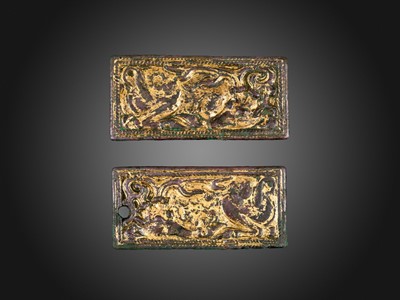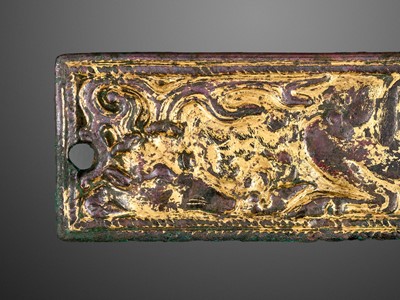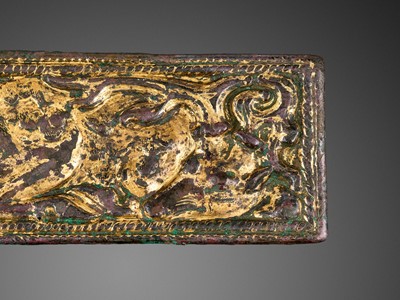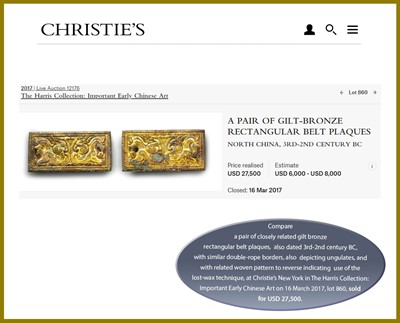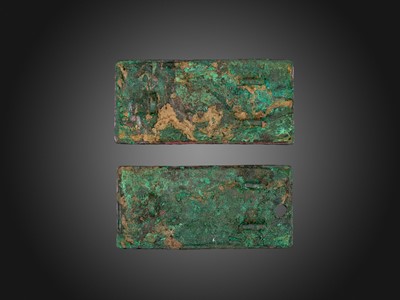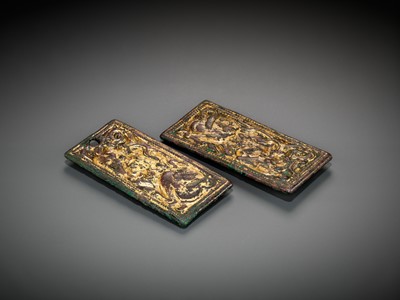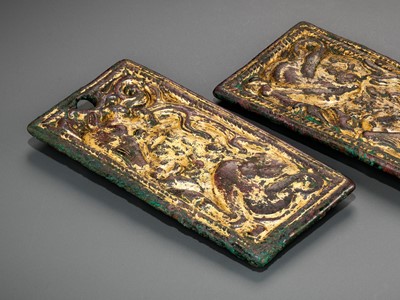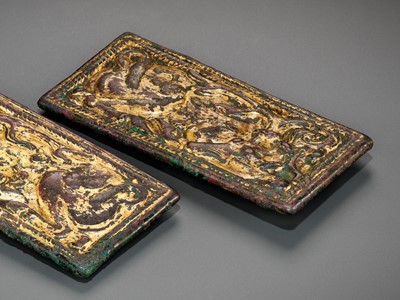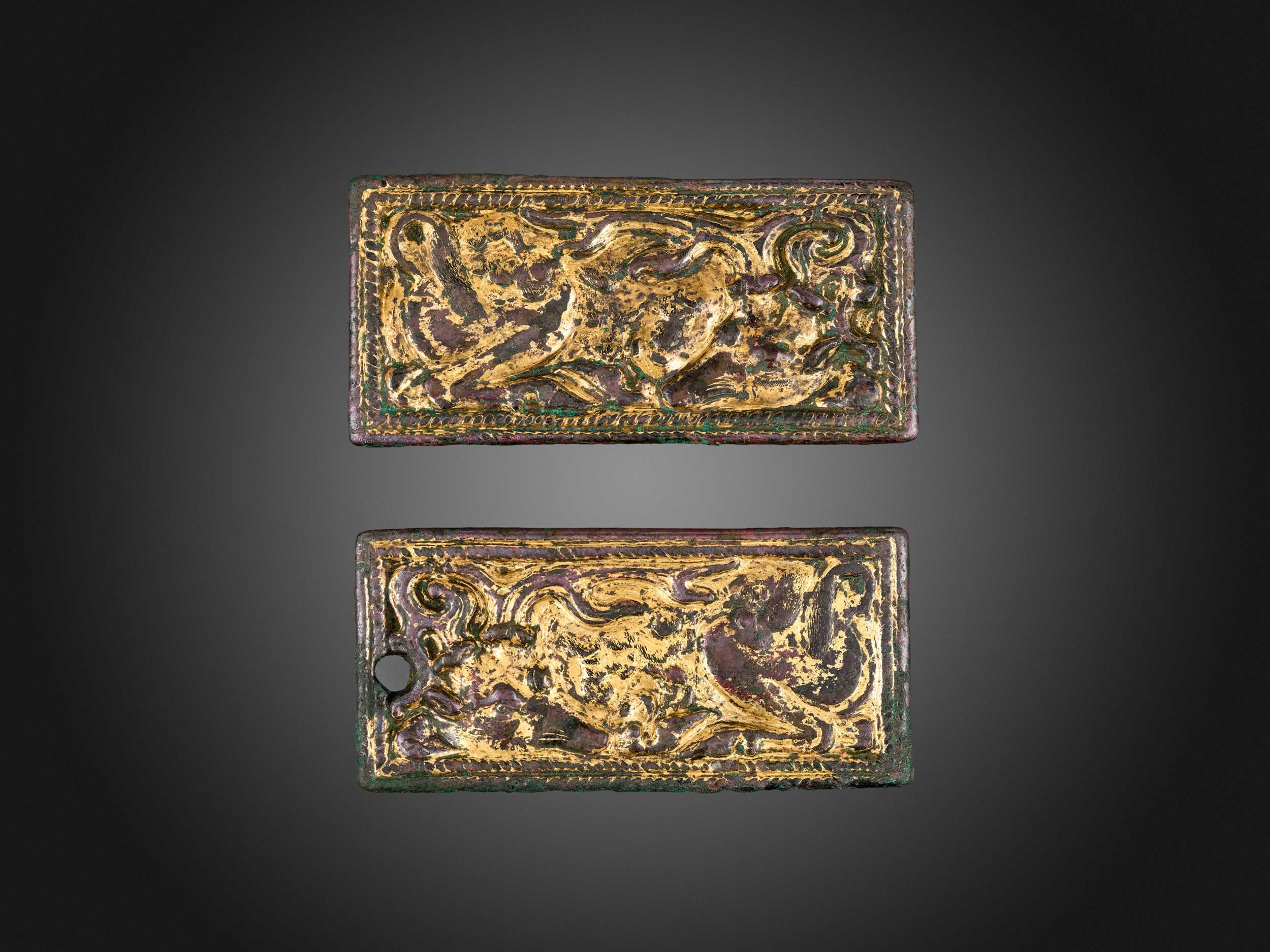16th Oct, 2021 10:00
TWO-DAY AUCTION - Fine Chinese Art / 中國藝術集珍 / Buddhism & Hinduism
337
A PAIR OF GILT-BRONZE RECTANGULAR BELT PLAQUES, 3RD-2ND CENTURY BC
公元前三至二世紀一對四方帶鈎鎏金銅牌
Sold for €1,770
including Buyer's Premium
North China. Each plaque is cast in relief with a recumbent stag, its prominent antlers, swept tail, and bent legs framing the noble animal’s muscular body, all within a double rope border. Each has three attachment loops on the reverse which bears a woven pattern indicating that the plaque was cast using the lost-wax/lost-textile process.
Provenance: Drouot Estimations, 24 May 2013, Sale no. 1431. French private collection, by repute acquired from the above.
Condition: Very good condition, commensurate with age. Extensive wear to gilt. Fine patina with malachite and cuprite encrustations as well as ancient soiling. One plaque with a drilled hole.
Weight: 91.4 g and 86.5 g
Dimensions: Size 10.3 x 4.8 cm and 10.5 x 4.9 cm
Lost-wax casting is the process by which a duplicate metal sculpture is cast from an original. Intricate works can be achieved by this method. The oldest known example of this technique is a 6,000-year-old amulet from the Indus Valley Civilization, but it did not appear in northern China until the 6th century BC. Materials other than wax can be used, including textile.
Literature comparison: Similar plaques have been found at sites associated with the Xiongnu. A related pair is illustrated by J. Rawson and E. C. Bunker, Ancient Chinese and Ordos Bronzes, Oriental Ceramic Society, Hong Kong, 1990, pp. 346-47, no. 225.
Auction result comparison: Compare a pair of closely related gilt bronze rectangular belt plaques, also dated 3rd-2nd century BC, with similar double-rope borders, also depicting ungulates, and with related woven pattern to reverse indicating use of the lost-wax technique, at Christie’s New York in The Harris Collection: Important Early Chinese Art on 16 March 2017, lot 860, sold for USD 27,500.
公元前三至二世紀一對四方帶鈎鎏金銅牌
中國北方。每塊銅牌上都可見臥著的雄鹿,突出的鹿角、後揚的尾巴和彎曲的腿體現了雄鹿的矯健,表現生動。四周繩紋邊框。背面有三個連接環,帶有編織圖案,表明飾板是使用失蠟法鑄造的。
來源:Drouot拍賣行,2013年5月 24日, 編號 1431;法國私人收藏,據説購於上述拍賣行。
品相:狀況極好,與其年齡相符。 鎏金廣泛磨損。 孔雀石綠色和赤色結殼,有包漿及舊時污漬。 其中一塊帶有鑽孔。
重量:分別為91.4克與86.5 克
尺寸:分別爲10.3 x 4.8 厘米 與10.5 x 4.9 厘米
拍賣結果比較:一對方形帶鈎鎏金銅牌,公元前三至二世紀,相似繩紋,同樣使用了失蠟法,見紐約佳士得 The Harris Collection: Important Early Chinese Art 2017年3月16日, lot 860, 售價USD 27,500。
North China. Each plaque is cast in relief with a recumbent stag, its prominent antlers, swept tail, and bent legs framing the noble animal’s muscular body, all within a double rope border. Each has three attachment loops on the reverse which bears a woven pattern indicating that the plaque was cast using the lost-wax/lost-textile process.
Provenance: Drouot Estimations, 24 May 2013, Sale no. 1431. French private collection, by repute acquired from the above.
Condition: Very good condition, commensurate with age. Extensive wear to gilt. Fine patina with malachite and cuprite encrustations as well as ancient soiling. One plaque with a drilled hole.
Weight: 91.4 g and 86.5 g
Dimensions: Size 10.3 x 4.8 cm and 10.5 x 4.9 cm
Lost-wax casting is the process by which a duplicate metal sculpture is cast from an original. Intricate works can be achieved by this method. The oldest known example of this technique is a 6,000-year-old amulet from the Indus Valley Civilization, but it did not appear in northern China until the 6th century BC. Materials other than wax can be used, including textile.
Literature comparison: Similar plaques have been found at sites associated with the Xiongnu. A related pair is illustrated by J. Rawson and E. C. Bunker, Ancient Chinese and Ordos Bronzes, Oriental Ceramic Society, Hong Kong, 1990, pp. 346-47, no. 225.
Auction result comparison: Compare a pair of closely related gilt bronze rectangular belt plaques, also dated 3rd-2nd century BC, with similar double-rope borders, also depicting ungulates, and with related woven pattern to reverse indicating use of the lost-wax technique, at Christie’s New York in The Harris Collection: Important Early Chinese Art on 16 March 2017, lot 860, sold for USD 27,500.
公元前三至二世紀一對四方帶鈎鎏金銅牌
中國北方。每塊銅牌上都可見臥著的雄鹿,突出的鹿角、後揚的尾巴和彎曲的腿體現了雄鹿的矯健,表現生動。四周繩紋邊框。背面有三個連接環,帶有編織圖案,表明飾板是使用失蠟法鑄造的。
來源:Drouot拍賣行,2013年5月 24日, 編號 1431;法國私人收藏,據説購於上述拍賣行。
品相:狀況極好,與其年齡相符。 鎏金廣泛磨損。 孔雀石綠色和赤色結殼,有包漿及舊時污漬。 其中一塊帶有鑽孔。
重量:分別為91.4克與86.5 克
尺寸:分別爲10.3 x 4.8 厘米 與10.5 x 4.9 厘米
拍賣結果比較:一對方形帶鈎鎏金銅牌,公元前三至二世紀,相似繩紋,同樣使用了失蠟法,見紐約佳士得 The Harris Collection: Important Early Chinese Art 2017年3月16日, lot 860, 售價USD 27,500。
Zacke Live Online Bidding
Our online bidding platform makes it easier than ever to bid in our auctions! When you bid through our website, you can take advantage of our premium buyer's terms without incurring any additional online bidding surcharges.
To bid live online, you'll need to create an online account. Once your account is created and your identity is verified, you can register to bid in an auction up to 12 hours before the auction begins.
Intended Spend and Bid Limits
When you register to bid in an online auction, you will need to share your intended maximum spending budget for the auction. We will then review your intended spend and set a bid limit for you. Once you have pre-registered for a live online auction, you can see your intended spend and bid limit by going to 'Account Settings' and clicking on 'Live Bidding Registrations'.
Your bid limit will be the maximum amount you can bid during the auction. Your bid limit is for the hammer price and is not affected by the buyer’s premium and VAT. For example, if you have a bid limit of €1,000 and place two winning bids for €300 and €200, then you will only be able to bid €500 for the rest of the auction. If you try to place a bid that is higher than €500, you will not be able to do so.
Online Absentee and Telephone Bids
You can now leave absentee and telephone bids on our website!
Absentee Bidding
Once you've created an account and your identity is verified, you can leave your absentee bid directly on the lot page. We will contact you when your bids have been confirmed.
Telephone Bidding
Once you've created an account and your identity is verified, you can leave telephone bids online. We will contact you when your bids have been confirmed.
Classic Absentee and Telephone Bidding Form
You can still submit absentee and telephone bids by email or fax if you prefer. Simply fill out the Absentee Bidding/Telephone bidding form and return it to us by email at office@zacke.at or by fax at +43 (1) 532 04 52 20. You can download the PDF from our Upcoming Auctions page.
How-To Guides
How to Create Your Personal Zacke Account
How to Register to Bid on Zacke Live
How to Leave Absentee Bids Online
How to Leave Telephone Bids Online
中文版本的操作指南
创建新账号
注册Zacke Live在线直播竞拍(免平台费)
缺席投标和电话投标
Third-Party Bidding
We partner with best-in-class third-party partners to make it easy for you to bid online in the channel of your choice. Please note that if you bid with one of our third-party online partners, then there will be a live bidding surcharge on top of your final purchase price. You can find all of our fees here. Here's a full list of our third-party partners:
- 51 Bid Live
- EpaiLive
- ArtFoxLive
- Invaluable
- LiveAuctioneers
- the-saleroom
- lot-tissimo
- Drouot
Please note that we place different auctions on different platforms. For example, in general, we only place Chinese art auctions on 51 Bid Live.
Bidding in Person
You must register to bid in person and will be assigned a paddle at the auction. Please contact us at office@zacke.at or +43 (1) 532 04 52 for the latest local health and safety guidelines.
